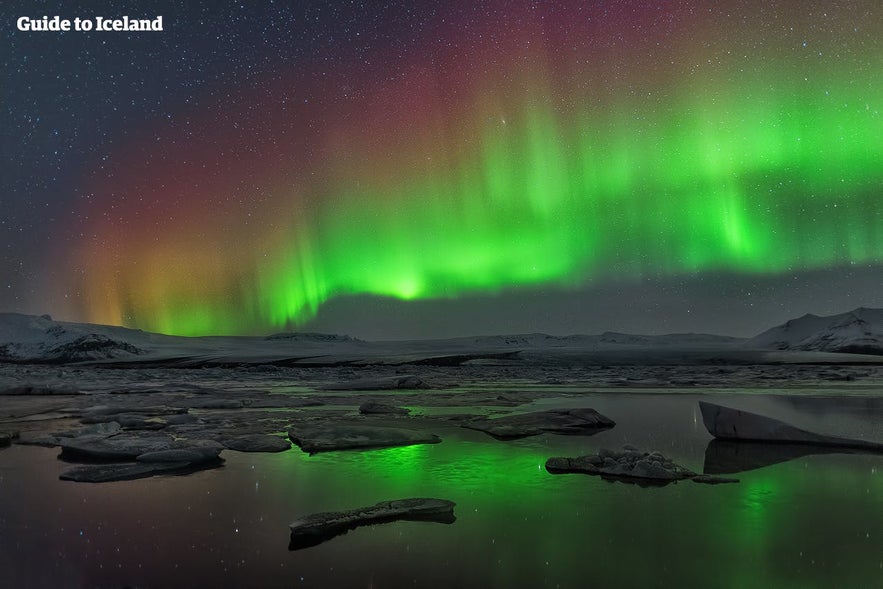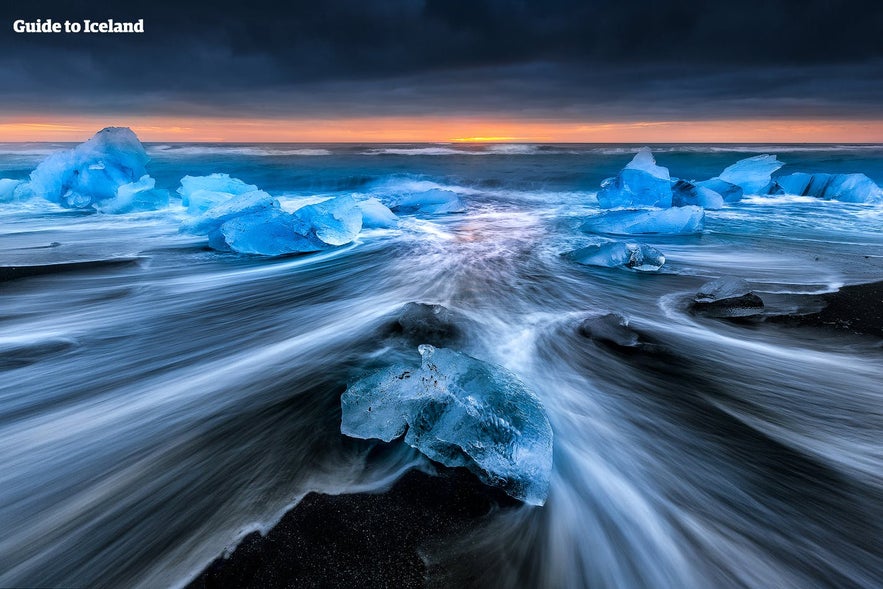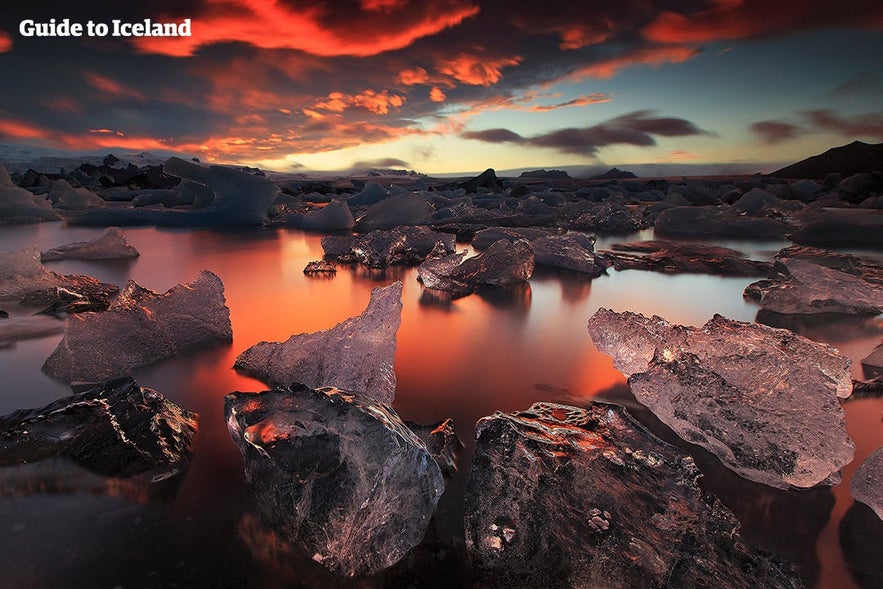
Glacier Lagoons in Iceland

Where can you find Iceland's glacier lagoons? What are the most stunning glacier lagoons in Iceland, and are there any hidden where you can avoid the crowds? Are the pictures of vast blue lakes filled with mighty icebergs doctored or real? Continue reading to learn all about this country’s magical glacier lagoons.
Iceland is a land of incredible, diverse sites, many of which are easy to access throughout the year. Visitors marvel over geysers, waterfalls, volcanoes and lava landscapes, every feature as dramatic and beautiful as the last.
Ask someone who has been to Iceland what their favourite destination was, however, and as likely as not, they will tell you it was the glacier lagoon.
What they will most likely be referring to is Jökulsárlón, in Iceland’s south-east. This feature is a vast lake formed by the meltwater of Breiðamerkurjökull glacier, deeper than any other in Iceland and filled year-round with icebergs which calve from the outlet. Some of these tower stories high, and the waters are home to many playful seals.
- See also: Seals and Seal Watching in Iceland
It is one of Iceland’s most photographed sites and draws visitors the world-over. Those who come will find that even the most well-taken image, however, cannot compare to what awaits them here. It truly is one of the country’s—and the world’s—most mesmerising places, where you can spend hours doing nothing but staring out in awe.
In spite of its popularity, however, it is not Iceland’s only glacier lagoon. Eleven percent of this nation’s surface area is covered with ice, and wherever there is a glacial outlet, there is a good chance you will find a lake at the base of it. While some of these will be little more than murky pools, others bear a similar majesty to the iconic Jökulsárlón.
What is a Glacier Lagoon?
Glacier lagoons are lakes that form at the base of glaciers and are particularly notable by glaciers that are retreating. As the ice caps recede, they erode a space in the earth where they once sat, which fills up with their meltwater. In Iceland, the first glacier lagoons began to form 10,000 years ago, at the end of the last ice age.
These lakes are notable for their colouration; as glacial ice is filled with sediment, they are often very murky, with the colours ranging from pale blues and greens to brown. Finding chunks of ice in them is very common, although few have bergs the size of those found at Jökulsárlón.
The number of glacier lagoons around Iceland is increasing, and those which already exist are largely expanding at a dramatic rate. While this provides visitors with plenty of opportunities to seek them out and enjoy them, it is an ominous sign of what lays ahead.
- See also: Iceland’s Troubled Environment
They prove the fact that the glaciers of Iceland are retreating at a radically fast rate, with some, such as Langjökull, expected to disappear within 150 years. Iceland currently loses eleven billion tonnes of ice annually.
Jökulsárlón is an example that illustrates this well. It did not form until around 1935, in response to the radical rise in temperatures that began to occur at the turn of the century, and since then, has grown rapidly. In 1975, it was just eight square kilometres; today, it covers eighteen and its rate of growth is only increasing.
The graphic below shows in no uncertain terms how much the lagoon has changed since 1984.
In a matter of years, Jökulsárlón will become a deep, plunging fjord.
Climate change accelerated by heavy industry and pollution is the root cause of these changes, something Iceland feels the effects of more than much of the rest of the world; the temperature here is increasing four times higher than the northern hemisphere average.
While this, unfortunately, means that both the glaciers and glacier lagoons will disappear in the near future, it is also motivation for visitors to get over to them while the opportunity still exists. Because of the current vastness of Jökulsárlón, now is an incredible time to see it.
From May to October, you can fully immerse yourself in this incredible, if temporary, site by taking an amphibious boat amongst the bergs and seals, or a more personal, if slightly more expensive, experience on a zodiac.
Jökulsárlón is one of the main destinations for two and three-day winter tours along the South Coast, although some operators also reach it and return to Reykjavík within a day, for those short on time.
Throughout summer, it can be easily driven to by those that rent a car, taking about five hours from the capital, and it is visited on certain day tours and many packages, such as this 4 Day Discount Summer Tour, which explores the south and west over four days.
Jökulsárlón, however, is not the only glacial lagoon travellers are encouraged to make the most of. There are many others which warrant a visit, the five best are detailed below.
Breidarlon Glacier Lagoon
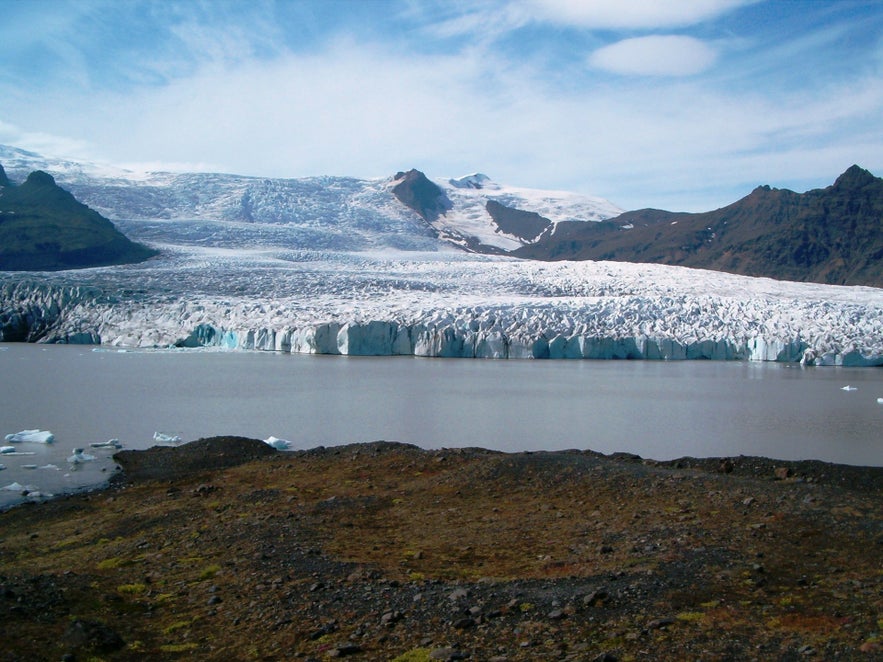
Hidden right beside Jökulsárlón, but far too often overlooked by visitors, is the Breiðárlón glacier lagoon. Though not as vast as its famous neighbour, the hills that surround it grant much greater views of the surrounding area, particularly of Breiðamerkurjökull.
In fact, from Breiðarlón, it is easy to see how this glacier tongue is connected to the much vaster Vatnajökull glacier, the largest ice cap in Europe, which in itself covers eight percent of Iceland’s surface area. The scale of this feature is awe-inspiring but becomes even more impressive when witnessed as a backdrop to this beautiful lake.
You won’t find any seals in Breiðarlón, and the icebergs will not quite reach the scale of those in the adjacent lagoon, but the area is likely to be far less busy. This makes it an ideal spot for landscape photographers, who want to capture the incredible, unique landscapes of Iceland without tourists ambling into their shot.
- See also: Photography in Iceland
Fjallsarlon Glacier Lagoon
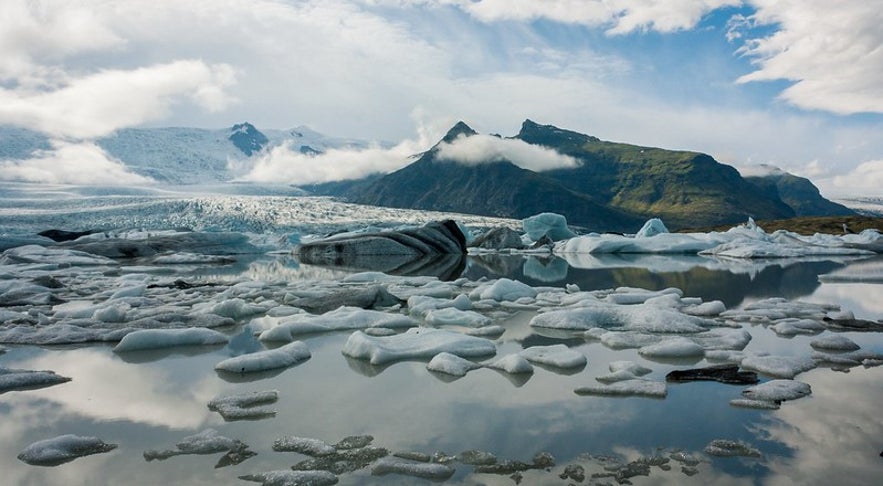 Photo by Mekanoide
Photo by Mekanoide
Connected to Breiðárlón by a short river is another glacier lagoon that, in spite of its proximity to the major sites of the south-east, is also often forgotten. Fjallsárlón, however, is an incredible place to admire the glaciers in peace, and, at the height of summer, you can find zodiac tours here that will allow you to explore it.
Even from shore, however, it is a fantastic site to marvel over. The lagoon boasts an incredible viewing point from Öræfajökull, a volcano that stands just to its side, which allows you to witness its scale and the surrounding area from above.
- See also: Volcanoes in Iceland
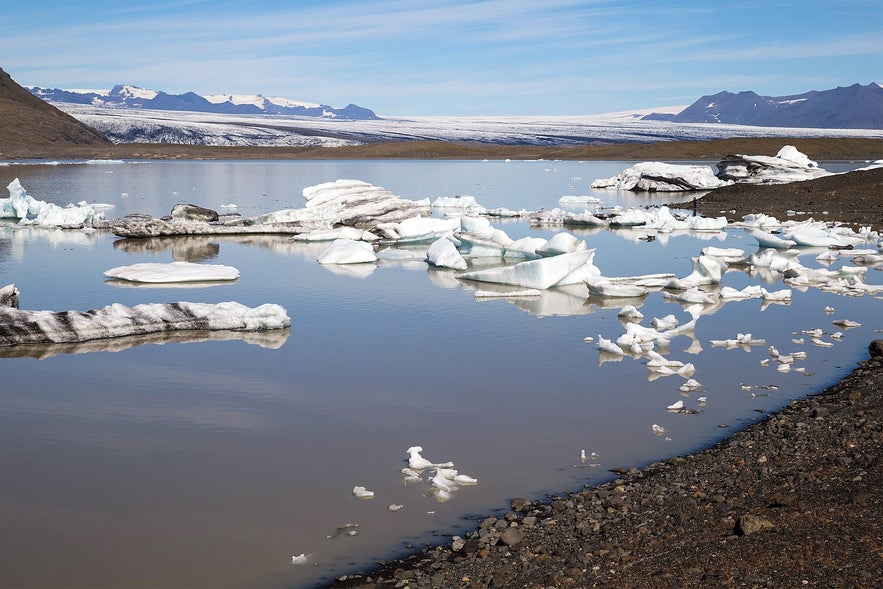
This volcano is a particularly interesting one, having erupted twice since settlement. The first eruption created the vast lava field in the Öræfasveit region, known as ‘the Wasteland’ in Icelandic, which contains many of the nearby sites of the area, such as the Skaftafell Nature Reserve.
Fjallsárlón is like Jökulsárlón in the sense that migratory seabirds, most notably the Skúa and Arctic Tern, nest on its shores throughout the summer months. At both locations, these birds should be admired with great caution; both species (particularly the latter) are notorious for the fierceness with which they defend their eggs and young. Get too close, and you will find a flock dive-bombing your head in a scene that resembles an Alfred Hitchcock movie.
- See also: Birds in Iceland
Fjallsárlón provided the set for a live performance of the song ‘Save Yourself’, by Icelandic blues band Kaleo, which you can watch above. While this video reveals the beauty of the lagoon, it is imperative you ignore the example set it in, and do not climb upon the icebergs.
Such an activity is incredibly dangerous and can easily result in death. Even if it doesn’t, it will waste the valuable time and resources of Iceland’s already overstretched rescue teams.
- See also: Dumbest Things to do in Iceland
Graenalon Glacier Lagoon
Grænalón is unique for a glacier lagoon in Iceland, as it is shrinking rather than expanding in spite of originating by the retreating Vatnjökull. Once as large as Jökulsárlón is now, at eighteen square kilometres, it now just lingers around the edge of the ice at the Skeiðarárjökull glacial tongue, a fraction of its former self.
- See also: Lakes in Iceland
Even so, it fills with icebergs just like those listed above, which often wash up on the shore akin to those at the Diamond Beach, which sits adjacent to Jökulsárlón, making it a great destination for photographers.
It is also aesthetically very different to the lagoons listed above, as the water within is a murky brown, rather than an opaque azure. Furthermore, it is far from the coast, located north-west of Skaftafell, and surrounded on three sides by ice-caps. The hiking trails around it are incredible for those who wish to immerse themselves in nature, far from any crowds.
Hvitarvatn Glacier Lagoon
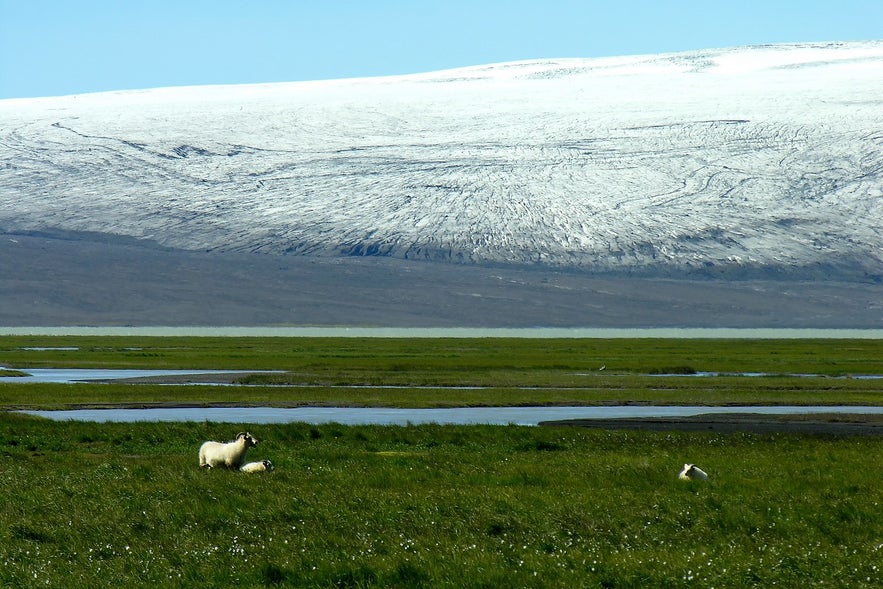
Hvítárvatn is the largest and most beautiful glacier lagoon off of Langjökull, the second largest glacier in Europe. Covering 30 square kilometres, it is up to 84 metres deep, and the sixth largest lake in Iceland. It can be found in the Highlands and is accessible in summer in a four-wheel-drive via the Kjölur Highland Route, or F35.
Hvítárvatn does not have as many icebergs as the other lagoons, and they are not quite as large, but it is a very common site to see small ones dotting its surface throughout the year. The lack of icebergs, however, means that on clear days, visitors have unobstructed views across the water to the beautiful, pristine glacier tongue that feeds into it.
Hvítárvatn is the source of the glacial river Hvítá, which runs through south Iceland. This river is perhaps the most visited in the country, due to the fact that it contains Gullfoss waterfall, one of the three points of the Golden Circle. In summer, it is also the most popular river for rafting, due to its gentle rapids and dramatic surroundings. Unlike ‘the Beast of the East’, rafting on the Hvítá river can be done by those without experience and is fun for the whole family.
Kaldalon Glacier Lagoon
Kaldalón is a very unique glacier lagoon, being the only one on this list located in the Westfjords. The singular glacier in this region is Drangajökull, alone amongst Iceland’s ice caps in the sense that it is the only one not retreating, due to its elevation and location in the country’s far north.
- See also: The Westfjords of Iceland
Drangajökull is little visited due to its remoteness and the fact that it is only easily accessible in the heights of summer. Those who do manage to reach it, however, will often find themselves to be the only ones present, making it an ideal spot for photographers and nature-lovers alike.
Kaldalón has become more of a fjord than a lagoon as it has expanded, connecting Drangajökull glacier to Ísafjarðardjúp, the largest bay in the region. It occasionally is dotted with icebergs creeping their way out to the ocean. It is most easily reached by driving up Route 635.
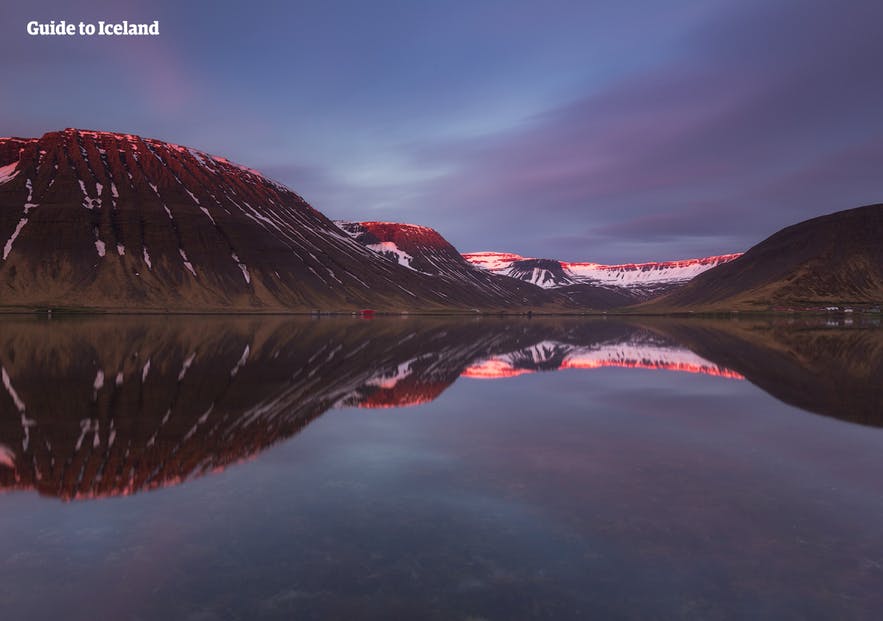
- Find a Drangajökull Glacier Adventure here
Those who visit should make the most of their time in this very remote part of Iceland, perhaps by visiting the nearby Hornstrandir Nature Reserve, the least populated region of the country. The flora and fauna here are unique and flourishing, making it a favourite destination for those passionate about wildlife.
Other Glacier Lagoons
Glacier Lagoons are not permanent features, appearing and disappearing as the glaciers move, recede and fluctuate. New ones, therefore, appear regularly, and ones which once drew visitors have since disappeared. It is often a good idea, therefore, to speak with locals around the glaciers you are travelling to, to get their insider knowledge of where little-known lagoons may be hiding.
The glacier lagoon in the video above, for example, called the Hoffell Lagoon near the town of Höfn, is one very few know about, and thus is a great place to visit to avoid the crowds.
Skaftafell also has glacier lagoons that come and go, which will be introduced to you on tours around the Nature Reserve.
Map of Glacier Lagoons in Iceland
To help aid your search for the lesser known glacier lagoons, a map has been included below that contains the whereabouts of each lake listed above. Be aware that some can only be reached in summer if you plan to drive yourself, and even in these months, it is best to check the weather website and roads website to make sure that they are safely accessible.
Did you find our guide to Iceland's glacier lagoons helpful? Do you have any additional questions that this article didn't cover? Feel free to ask away, or leave your thoughts and comments in the box below!
関連記事
アイスランドの白夜について
アイスランドの白夜を徹底解説。アイスランドでは何月に白夜が起きる?朝焼け・夕焼けの時間がどのくらい続くの?外が明るい時はどうやって寝ればいい?など、アイスランドの白夜に関する疑問にすべて答えます。 北極圏に近いアイスランドでは、日が沈まない「白夜」と呼ばれる現象がおきます。夜が真っ暗になることはなく、空が赤、ピンク、紫に染まったまま朝焼けを迎えるんです。 白夜の季節はずっと外が明るいので...もっと読む
火山の国アイスランド
火山の国アイスランド。現在でも温泉が湧き出たり、地熱活動が活発だったりと、火山はアイスランドの大きな特徴です。アイスランドにはいくつ火山があるの?どれくらいの頻度で噴火するの?旅行中に噴火することはある?火山があっても安全に旅行できるの?そんな疑問にこちらの記事でお答えします! スリーフヌカギグル火山の火口探検!インサイド・ザ・ボルケーノツアー アイスランド大自然を巡る、サマーパッケージ7...もっと読む4月のアイスランド:観光情報、天気、オーロラなど
4月のアイスランドを徹底解説。お天気・気温は?雪はまだある?おすすめのアクティビティは?オーロラは見られる?そもそも4月のアイスランド旅行ってどうなの?といった素朴な疑問にお答えします。 結論から言うと、4月のアイスランド旅行はとってもおすすめです。4月は春の光が少しずつ広がり、島が冬眠から覚める喜びの季節。運転しやすくなるのでケプラヴィーク国際空港でレンタカーを借りて、アイスランドを一周す...もっと読む

アイスランド最大の旅行アプリをスマートフォンにダウンロード。旅のすべてを1か所で管理できます。
アイスランド最大の旅行マーケットプレイスをポケットに。スマートフォンのカメラでQRコードを読み取り、表示されるリンクをクリックしてください。電話番号またはメールアドレスを入力すれば、SMSやEメールでもダウンロードリンクを受け取ることができます。
